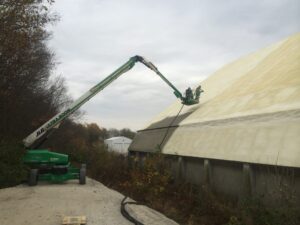USING SPRAY FOAM TO OVERCOME ROOF OBSTACLES
There are some roofing situations are simply out of the ordinary. They are unique, challenging, and not the norm. Using traditional roofing systems in these situations can be extremely difficult, because most roof systems are manufactured with the standard roof in mind. This is the way they should be manufactured: you can’t plan for the exceptions, just the general rule.
A system that isn’t quite as rigid and defined as those traditional roofing systems can provide an opportunity to adjust and adapt to these unique situations. Spray foam roofs are “manufactured” on the roof surface. They are made of raw materials that are combined directly on the surface of the roof. Let’s see how this ability to adapt to the exact roof scenario can help building owners with out of the ordinary roof features.

Barrel Roofs
These are roofs that have an increasing slope from center to edge. The top of the roof may be completely flat, while the edges are very steep. These roofs look like a barrel because of their rounded edges, and they are dangerous because of it.
Installing traditional roof systems on barrel roofs is very difficult because most systems come in flat panels and aren’t designed to fit a roof with a changing slope. Enter spray foam, which is simply spray-applied to the roof slope. Installing foam on barrel roofs is no problem thanks to its flexibility.
Many Roof Penetrations
If your roof has a large number of roof penetrations and other items, installing a standard roof can be very difficult. Working a metal roof around vents, or a membrane roof around skylights can be a pain and lead to wasted material. However, a spray foam roof can be installed directly up to the edge of these penetrations. Foam is self-flashing, meaning you don’t need to cut around or carefully tie into penetrations. The foam simply sprays and adheres directly to the penetrations and that is that!
Different Roof Levels and Materials
Many of the buildings in use today were built without a long-term plan in place for additions and changes. As companies grow, they add to their buildings. Depending on if the same decision make is still in place or not, this can lead to the company using different roofing materials, having multiple roof heights and levels, and different lifespans on each section. Each individual section has to be tied in to the others, but that can be difficult.
Spray foam can be applied directly to the surface of many different roofing materials. This means that even if you have several different material types on your roof, spray foam can still go over top of them. Foam is also self-flashing (as mentioned above), so the crossover sections between roofs of different heights and materials can be easily tied in with foam. It just creates a bridge of sorts to connect them. Foam can easily and effectively solve your roofing problems if you have varying roof levels and materials.
Conclusion
Commercial roofing isn’t always an easy subject. There are many variations and exceptions from one roof to another, and there are even variations on individual roofs. Utilizing a system that is versatile and able to adjust is a great way to combat these changes. That is one aspect of spray foam roofing that makes it so valuable: the ability to adapt. Give us a call today if you’d like to learn more about spray foam and how it can help you.
